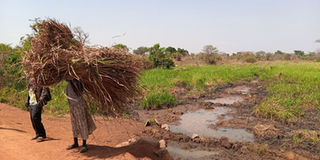Communities reap big from wetland restoration

A woman carries grass she harvested from Otol wetland, Agweng Sub-county in Lira District, March 16. Locals are now reaping benefits after restoring the wetland systems. PHOTO | FILE
What you need to know:
- Eight years ago, heavy floods repeatedly swept away a busy access road connecting Lira and Otuke districts, leaving the communities isolated.
Efforts directed towards the conservation of wetlands by communities in Lira and Otuke districts are yielding positive results.
Eight years ago, heavy floods repeatedly swept away a busy access road connecting Lira and Otuke districts, leaving the communities isolated.
This was due to the degradation of Otol swamp located in Orit Parish, Agweng Sub-county in Lira District.
Mr Fabious Otike, the Lira District natural resources officer, says it was a very big liability to the district which had to fix the bridge whenever a disaster struck.
“The floods would wash away the culverts installed at Otol swamp-crossing, rendering the road impassable,” he said in an interview on Tuesday.
He added that the district would spend on average Shs25m annually to repair the broken road network.
However, in 2013, International Union for Conservation of Nature (IUCN) in partnership with Lira District administration sensitised the residents on the importance of wetlands.
The residents were also taken through the values they were likely to lose as a result of their action of degrading the wetlands.
The community then took the lead in ensuring that they demarcated the boundary of Otol wetland systems and suspended cultivation on the catchment area.
The interventions by the communities, which seek to build resilience of communities to climate-related disasters through community led catchment restoration, livelihood enhancement and natural resource government initiatives, have been funded by Austrian Development Agency (ADA).
Today, Otol wetland is able to regenerate naturally.
“This wetland that feeds River Moroto is now a permanent wetland, where you find water in the catchment area throughout the year,” Mr Otike said.
He added that in the past, all the swamp and community water sources within the area would dry up within a short span during the prolonged dry spell .
The swamp naturally recharges the groundwater reserves.
Benefits
Today, the locals are reaping the benefits of wetland restoration efforts.
“We have taken about five, six years without fixing this swamp-crossing because the vegetation at the swamp now regulates the flow of water such that when it is going towards the swamp-crossing it flows slowly,” the Mr Otike said.
He added: “That means we have been able to save Shs150m which we are able to invest in other road projects across the district.”
Traders from Lira and Otuke are now using this road to transport their goods to Lira City, hence improving their livelihoods, which was not the case before.
Mr Richard Munu, the Orit Parish chief, says this intervention has helped them in ensuring that their road is protected.
He also says: “the locals are now getting other benefits like cutting grass for thatching their houses, doing communal fishing and eating fish.”
Ms Hellen Okello, a resident of Wigot “A” Village, says they have also benefited from the Community Environment Conservation Fund (CECF), as part of enhancing community livelihoods.
CECF, which provides cheap credit to the communities, while catalysing them to engage in catchment restoration and management, was introduced by the International Union for Conservation of Nature (IUCN) in 2013.
According to the implementing agency –the Ministry of Water and Environment –a total of Shs56 million has been disbursed to Orit Parish as seed fund between 2013 and 2020.
These funds are accessed by more than 800 households which are engaging in various livelihood options such as small scale trade, livestock rearing, and poultry rearing among others.
The beneficiaries say the funds, which have increased to about Shs100 million, has boosted income and provided a financial cushion to the vulnerable youth, women and men within the parish.
Ms Grace Awor, a resident of Awielem Village, says she has borrowed the money and invested in a fish business.
Another farmer, Ms Hellen Okello, says she uses the profit realised from the borrowed funds to send her children to school.
“I borrowed Shs25,000 and used it to buy five hens and kept it for one year, and within that period I sold the first batch and bought three goats,” Mr Sam Ogwal, another beneficiary, says.
Stocktaking
Mr Richard Musota, the manager of Upper Nile Water Management Zone at the Ministry of Water and Environment, said the CECF model is effective in mobilising community action in restoration and securing livelihoods of communities.
“I want to thank the community for the effort they have put in restoring the wetlands,” he said during a field visit to Orit Parish on Tuesday.
On Tuesday, a team from the Ministry of Water and Environment, CARE International, Meaningful Empowerment for Change and Poverty Alleviation (MECPA) and SNV Uganda was doing stocktaking in Orit in regards to management of water and environment resources.
Measures
Restoration of wetlands
Over the past years, tested dry land restoration models like community led wetland restoration and management, and point water source management has been scaled up in terms of scale, size and impact areas.
Communities have also been supported to pursue selected climate resilient value chains that deliver sustainable livelihood impacts within the selected parishes as is the case in Orit.




